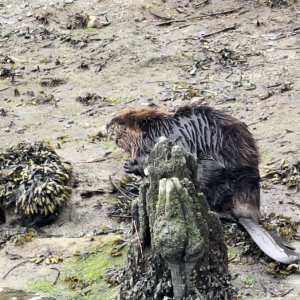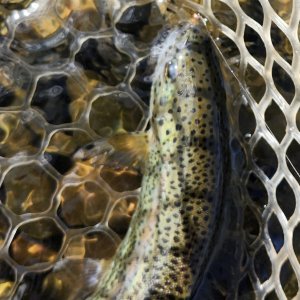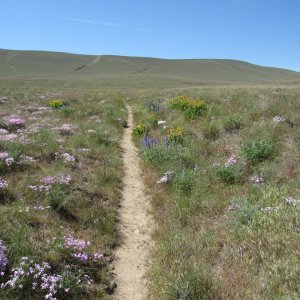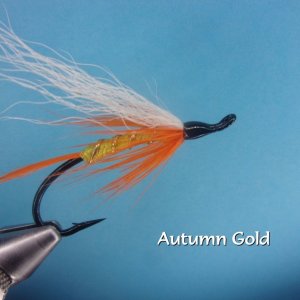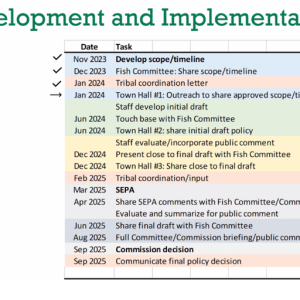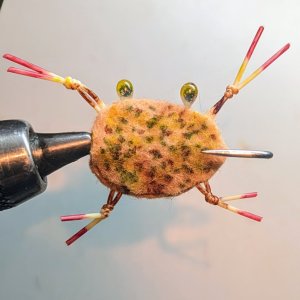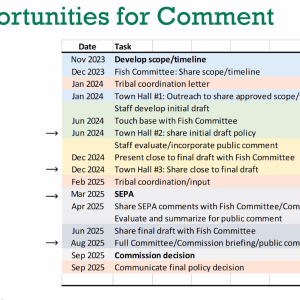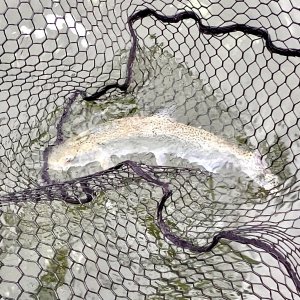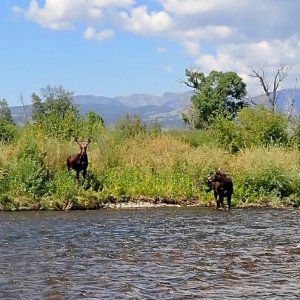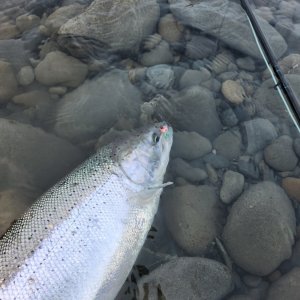Fishing the Last Mile First – Part IV – Tips and Advice
The Fishing the Last Mile First concept was first published in the Spring 2014 issue of Kayak Angler Magazine.
Mike Cline, Bozeman, Montana
There are a lot of basic kayaking skills that don’t need to be addressed in this article. They would apply whether you are Fishing the Last Mile First or not. But there are a few skills that will make the Fishing the Last Mile First experience safer and more productive.
Entering and Exiting the Kayak--There are two things you do a lot when Fishing the Last Mile First—entering and exiting the kayak; and wading with the kayak tethered to your waist. Both require some discussion. Having taken a number of friends and acquaintances on a Fishing the Last Mile First trip, I quickly learned that most don’t know how to enter and exit a kayak properly. The instinct is to step into the kayak with one foot. If the kayak is floating at the time, the kayak pushes away, and the anglers high center of gravity makes it impossible to get the other foot moving. The proper method is rather simple. Put your butt into/onto the kayak seat first and swing your legs over the gunnel to complete the process. This keeps the overall center of gravity low and prevents the kayak from sliding away from the angler. Exiting the kayak is just a reverse process. Swing one leg over the gunnel and make contact with the river bottom, then the other leg and stand up. Do not try and stand up first in the kayak and step out.
Entering and exiting a kayak in moving water can be challenging if you don’t think it through. First, whenever possible, enter and exit the kayak on the upstream or shoreline side of the kayak. If you are downstream and slip, the kayak might run into you and knock you down. This is particularly important if you’ve grounded the kayak in a fast, shallow riffle. When you take your weight off the kayak it is going to move. When wading in unfamiliar waters, exceptionally clear water or streams with sandy, muddy areas, use your paddle to test the depth and firmness of the stream bottom. In exceptionally clear water, depth can be deceiving. Areas with soft mud and sand should be avoided as they can sometimes get the angler stuck in ways that are difficult to deal with. Always stow your paddle before you exit the kayak. A loose paddle can fall out of the boat or obstruct your legs, etc. Most kayaks have some method of securing the paddle, use it before you exit.
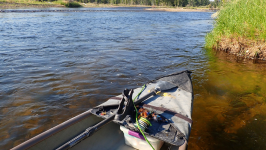
Stowing a tethered paddle is an essential step while wading
Wading with a Tethered Kayak is somewhat different than normal wading, but the tethered kayak provides the angler some advantages over free wading. There are essentially three ways to wade with a tethered kayak. First, the kayak is allowed to drift behind the angler on the entire length of the tether. This can be done with the tether around the waist being the point of angler contact or having the angler hold the tether with one hand. People have expressed concern that a kayak in current tethered to an angler’s waist would tend to pull the angler downstream. Lightweight kayaks draft but 1-2” of water when empty and are hydrodynamically efficient on the surface. Although they exert some pressure on the angler, it is minimal to the point of insignificance. A second method of wading with the tether is useful when wading up the edges of riffles, across a riffle or tail-out or navigating shoreline obstructions. The tether is gathered up in loops until the angler is holding the tether about two to three feet from the bow of the kayak. This gives the angler greater control over the path of the kayak and puts the burden on the arm/shoulder of the angler, not the waist. The added benefit of this method in swifter or deeper water is that the short-tethered kayak acts just like a wading staff providing a third point of contact for the angler to stabilize.
At any point with the short tether the angler decides to fish, the tether is just released, and the kayak allowed to drift backwards out of the way. A third approach is very useful when wading deeper banks, up to thigh or even waist deep. Pull the kayak up to your position and place the tether on the bow. Use the kayak bow as a point of contact while wading the deep water.
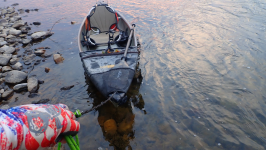
Shortening Up on the Tether to Wade Upstream Thru Riffles and Shallow Water
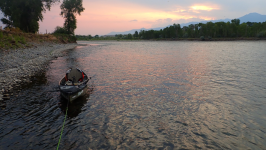
Allow the Boat to Drift Behind You on Smooth Water
Rod Holders and Rod Safety
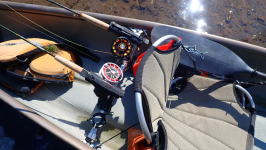
One of the advantages of the Fishing the Last Mile First strategy is the ability to carry multiple, fully rigged rods ready to go. This is typically done with some of sort of rod holder suitable for the rod type. Most of these are adjustable. On wide rivers where you are unlikely to encounter tight, bankside brush or trees, rod holders can be set so the rods are more parallel to the water. This is particularly useful with long fly rods that if stowed vertically can sometimes interfere with long back casts. However, if in a narrower river where wading tight to brushy banks is inevitable, rods should be stowed more vertically to prevent tangling with bankside brush. It is a tradeoff. Regardless, extra rods should be secured in rod holders to prevent loss or breakage.
River Intimacy
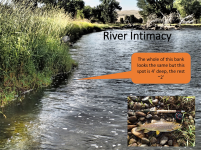
Wading Up an Outside Bend Allowed Me to Discover This Subtle Hole Left When a Cottonwood Tumbled Into the River.
Over the long term, the Fishing the Last Mile First angler develops an intimate relationship with the waters being fished. As the angler is almost always wading along banks and mid-stream bars instead of walking up or down the shoreline out of the water, subtle clues about where the fish are become engrained in your experience. You discover a small pothole in a mid-stream bar, one foot deeper than the surrounding water. A bankside hole, essentially undetectable streamside reveals itself as you wade up a deep bank. As you fish these places, you find that most often you connect. Overtime you mentally catalog all the nuances of the streams you fish and can focus attention on those areas of the stream you know typically hold fish.
Taking Advantage of the Last Mile First Strategy
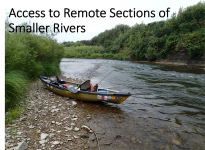
The Fishing the Last Mile First Strategy was conceived with three strategic goals in mind. First, the ability to wade fish productive waters before anyone else gets to them. Second, to fish in uncrowded conditions and third to be able to access remote waters solo without the need for partners, shuttles, trespassing or heavy boats. A lesson I learned from the bass fishers when I was living in the south has paid big dividends for me here in SW Montana. On large reservoirs common in the South finding fish can be a challenge. The savvy bass angler finds a discrete section of the reservoir and breaks it down like it is the only water available. They take a random creek and explore every nuance from source to mouth to find fish—where are they holding, what depth, what are they responding to? They turn a large reservoir into a small lake by concentrating on discrete sections to identify a pattern. This is a valuable tactic for the Fishing the Last Mile First angler.
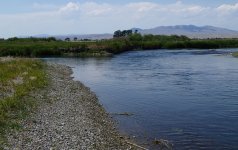
A rare place where fish roam and anglers are rare - Fishing the Last Mile First gets you there.
On medium to large rivers I look for access points separated by at least five to ten miles and sections above an access point with lots of productive water like riffle corners, buckets, long deep runs, islands and small channels. The more variety in the available water, the more likely you’ll find lots of productive water in the few miles upstream from the access point, water that’s been rested overnight. Floaters bypass a lot of productive water because it is difficult to reach or they just can’t be on two sides of the river at once. There are plenty of rivers where drift boats and rafts just don’t go either because the river is too narrow, the drift is just too long or fishing from a boat is prohibited. These are the places the Fishing the Last Mile First angler should seek out. Long sections of rivers surrounded by private land are also good choices. As long as the angler can find legal access to the stream and stay below the high water mark a lot of essentially untouched water can be fished in utter solitude.
Fishing the Last Mile First strategy has proven itself over 25 years of my angling adventures. I am wedded to it as it works and brings fish to hand. Give it a try.
The Fishing the Last Mile First concept was first published in the Spring 2014 issue of Kayak Angler Magazine.
Fishing the Last Mile First – Part I – An Angling Strategy
Fishing the Last Mile First – Part II – Boats and Gear
Fishing the Last Mile First – Part III – Fundamentals
The Fishing the Last Mile First concept was first published in the Spring 2014 issue of Kayak Angler Magazine.
Mike Cline, Bozeman, Montana
There are a lot of basic kayaking skills that don’t need to be addressed in this article. They would apply whether you are Fishing the Last Mile First or not. But there are a few skills that will make the Fishing the Last Mile First experience safer and more productive.
Entering and Exiting the Kayak--There are two things you do a lot when Fishing the Last Mile First—entering and exiting the kayak; and wading with the kayak tethered to your waist. Both require some discussion. Having taken a number of friends and acquaintances on a Fishing the Last Mile First trip, I quickly learned that most don’t know how to enter and exit a kayak properly. The instinct is to step into the kayak with one foot. If the kayak is floating at the time, the kayak pushes away, and the anglers high center of gravity makes it impossible to get the other foot moving. The proper method is rather simple. Put your butt into/onto the kayak seat first and swing your legs over the gunnel to complete the process. This keeps the overall center of gravity low and prevents the kayak from sliding away from the angler. Exiting the kayak is just a reverse process. Swing one leg over the gunnel and make contact with the river bottom, then the other leg and stand up. Do not try and stand up first in the kayak and step out.
Entering and exiting a kayak in moving water can be challenging if you don’t think it through. First, whenever possible, enter and exit the kayak on the upstream or shoreline side of the kayak. If you are downstream and slip, the kayak might run into you and knock you down. This is particularly important if you’ve grounded the kayak in a fast, shallow riffle. When you take your weight off the kayak it is going to move. When wading in unfamiliar waters, exceptionally clear water or streams with sandy, muddy areas, use your paddle to test the depth and firmness of the stream bottom. In exceptionally clear water, depth can be deceiving. Areas with soft mud and sand should be avoided as they can sometimes get the angler stuck in ways that are difficult to deal with. Always stow your paddle before you exit the kayak. A loose paddle can fall out of the boat or obstruct your legs, etc. Most kayaks have some method of securing the paddle, use it before you exit.

Stowing a tethered paddle is an essential step while wading
Wading with a Tethered Kayak is somewhat different than normal wading, but the tethered kayak provides the angler some advantages over free wading. There are essentially three ways to wade with a tethered kayak. First, the kayak is allowed to drift behind the angler on the entire length of the tether. This can be done with the tether around the waist being the point of angler contact or having the angler hold the tether with one hand. People have expressed concern that a kayak in current tethered to an angler’s waist would tend to pull the angler downstream. Lightweight kayaks draft but 1-2” of water when empty and are hydrodynamically efficient on the surface. Although they exert some pressure on the angler, it is minimal to the point of insignificance. A second method of wading with the tether is useful when wading up the edges of riffles, across a riffle or tail-out or navigating shoreline obstructions. The tether is gathered up in loops until the angler is holding the tether about two to three feet from the bow of the kayak. This gives the angler greater control over the path of the kayak and puts the burden on the arm/shoulder of the angler, not the waist. The added benefit of this method in swifter or deeper water is that the short-tethered kayak acts just like a wading staff providing a third point of contact for the angler to stabilize.
At any point with the short tether the angler decides to fish, the tether is just released, and the kayak allowed to drift backwards out of the way. A third approach is very useful when wading deeper banks, up to thigh or even waist deep. Pull the kayak up to your position and place the tether on the bow. Use the kayak bow as a point of contact while wading the deep water.

Shortening Up on the Tether to Wade Upstream Thru Riffles and Shallow Water

Allow the Boat to Drift Behind You on Smooth Water
Rod Holders and Rod Safety

One of the advantages of the Fishing the Last Mile First strategy is the ability to carry multiple, fully rigged rods ready to go. This is typically done with some of sort of rod holder suitable for the rod type. Most of these are adjustable. On wide rivers where you are unlikely to encounter tight, bankside brush or trees, rod holders can be set so the rods are more parallel to the water. This is particularly useful with long fly rods that if stowed vertically can sometimes interfere with long back casts. However, if in a narrower river where wading tight to brushy banks is inevitable, rods should be stowed more vertically to prevent tangling with bankside brush. It is a tradeoff. Regardless, extra rods should be secured in rod holders to prevent loss or breakage.
River Intimacy

Wading Up an Outside Bend Allowed Me to Discover This Subtle Hole Left When a Cottonwood Tumbled Into the River.
Over the long term, the Fishing the Last Mile First angler develops an intimate relationship with the waters being fished. As the angler is almost always wading along banks and mid-stream bars instead of walking up or down the shoreline out of the water, subtle clues about where the fish are become engrained in your experience. You discover a small pothole in a mid-stream bar, one foot deeper than the surrounding water. A bankside hole, essentially undetectable streamside reveals itself as you wade up a deep bank. As you fish these places, you find that most often you connect. Overtime you mentally catalog all the nuances of the streams you fish and can focus attention on those areas of the stream you know typically hold fish.
Taking Advantage of the Last Mile First Strategy

The Fishing the Last Mile First Strategy was conceived with three strategic goals in mind. First, the ability to wade fish productive waters before anyone else gets to them. Second, to fish in uncrowded conditions and third to be able to access remote waters solo without the need for partners, shuttles, trespassing or heavy boats. A lesson I learned from the bass fishers when I was living in the south has paid big dividends for me here in SW Montana. On large reservoirs common in the South finding fish can be a challenge. The savvy bass angler finds a discrete section of the reservoir and breaks it down like it is the only water available. They take a random creek and explore every nuance from source to mouth to find fish—where are they holding, what depth, what are they responding to? They turn a large reservoir into a small lake by concentrating on discrete sections to identify a pattern. This is a valuable tactic for the Fishing the Last Mile First angler.

A rare place where fish roam and anglers are rare - Fishing the Last Mile First gets you there.
On medium to large rivers I look for access points separated by at least five to ten miles and sections above an access point with lots of productive water like riffle corners, buckets, long deep runs, islands and small channels. The more variety in the available water, the more likely you’ll find lots of productive water in the few miles upstream from the access point, water that’s been rested overnight. Floaters bypass a lot of productive water because it is difficult to reach or they just can’t be on two sides of the river at once. There are plenty of rivers where drift boats and rafts just don’t go either because the river is too narrow, the drift is just too long or fishing from a boat is prohibited. These are the places the Fishing the Last Mile First angler should seek out. Long sections of rivers surrounded by private land are also good choices. As long as the angler can find legal access to the stream and stay below the high water mark a lot of essentially untouched water can be fished in utter solitude.
Fishing the Last Mile First strategy has proven itself over 25 years of my angling adventures. I am wedded to it as it works and brings fish to hand. Give it a try.
The Fishing the Last Mile First concept was first published in the Spring 2014 issue of Kayak Angler Magazine.
Fishing the Last Mile First – Part I – An Angling Strategy
Fishing the Last Mile First – Part II – Boats and Gear
Fishing the Last Mile First – Part III – Fundamentals
Last edited:

